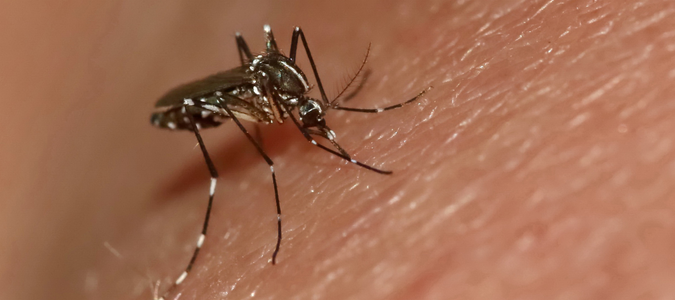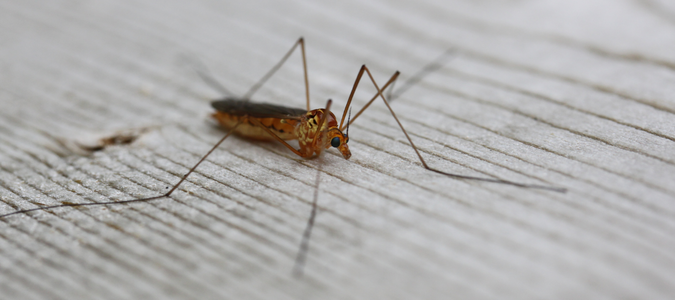If you see a large black and white mosquito, this is an Asian tiger mosquito. Let’s take an in-depth look at the Asian tiger mosquito and understand how these pests breed and spread.
What Are Asian Tiger Mosquitoes?
Asian tiger mosquitoes, also known as Aedes albopictus, are an invasive black and white mosquito species that carry numerous diseases.
This black and white mosquito species have a short flight range of 100 to 200 yards. But since they prefer standing water as their breeding grounds, be on the lookout for these areas to identify them quickly.
Once identified, homeowners should eliminate these potential breeding grounds. Contacting your local pest control is ideal for dealing with the Asian tiger mosquito population.
The Appearance of Asian Tiger Mosquitoes
As mentioned, Asian tiger mosquitoes are easily identifiable as black and white mosquitoes. This species has a silver-white stripe from the head down to the back. Their legs are also striped in black and white.
Like most mosquitoes, the male antenna is bushier—it’s where the auditory receptors are located to recognize the female buzzing.
Other characteristics that the Asian tiger mosquitoes have are:
- A small body: adults are less than three-eighths of an inch long.
- Different sizes between males and females: males are usually 20% smaller than females.
- Striking pattern: a single silvery-white line of tight scales runs between the eyes and down the dorsal side of the thorax.
- High agility: this species bites rapidly and can easily escape people’s attempts to swat it.
There is also another black and white mosquito, the yellow fever mosquito (Aedes aegypti), that is also black and white with stripes on its legs. However, it has a harp shape on its back instead of a stripe.
If you notice any of these mosquitoes on your property, contact a pest control service to discuss measures for mosquito control. They will have the tools and skills needed to reduce populations of mosquitoes.
How Do Asian Tiger Mosquitoes Behave?
One of the most notable distinctions in Asian tiger mosquitoes’ behavior is that while most other mosquitoes feed at night, Asian tiger mosquitoes typically feed during the day.
This black and white mosquito species are also active year-round in warm regions and can survive in temperate climates by overwintering. This term explains how some mosquitoes spend time over the winter, usually hibernating in hollow logs or burrows.
The females lay their eggs near stagnant water, which can be found inside any container that could catch rain and hold the water for a few weeks.
Common breeding grounds for Asian tiger mosquitoes include tires, tarps, flower pots (including saucers underneath them), bird baths and drain pipes.
Infestation and Prevention of Asian Tiger Mosquitoes
How can you tell if this pest has infested your home or yard? There are obvious signs of a mosquito infestation, such as:
- Buzzing: the female tiger mosquito buzzes audibly during the day.
- Bites: everyone reacts differently to mosquito bites, ranging from small, swollen bumps to welts to everything in between.
- Eggs in standing water: immature mosquitoes in standing water are a red flag.
The first and most important preventative step to repelling mosquitoes is eliminating potential breeding grounds for Asian tiger mosquitoes. Look out for areas around your home holding water for over a few days. If you find them, eliminate them.
Other suggestions to protect yourself against mosquito-borne illnesses are:
- Minimizing your time outdoors during the mosquitoes’ active hours during the day.
- Wearing light-colored clothes. Research has shown that mosquitoes are attracted to some colors more than others.
- Using insect repellent.
A pest control service will know the most effective way to prevent and minimize an Asian tiger mosquito population.
Risks of Asian Tiger Mosquitoes
Originally native to Southeast Asia, this species was introduced to the United States through imported tire casings for recapping. Since 1985, it has spread to over 20 states in the United States.
Asian tiger mosquitoes can carry a variety of viruses, including La Crosse encephalitis virus and West Nile virus, although the species’ role as a disease carrier in the U.S. is unclear.
Other mosquito-borne diseases this species can carry are dengue fever, yellow fever and the Chikungunya virus.
People’s reactions to Asian tiger mosquito bites vary from mild irritation to inflammation and swelling. These mosquitoes are aggressive, often biting more than once in one sitting.
Fly Versus Mosquito: Identification Tips
It’s important to note that you can also mistake other insects for mosquitoes. A crane fly, for example, is often confused with mosquitoes because of its nickname, “mosquito hawk” or “mosquito eater.”
Another contributing factor is their slim and long bodies resembling a mosquito more than a fruit fly. But significant differences distinguish the two.
Crane Fly Versus Mosquito: Sizes and Shapes
Crane flies are bigger than mosquitoes, with long, straight bodies measuring around an inch and a half. Meanwhile, mosquitoes are only between a tenth and half an inch long, with a bent thorax and abdomen giving them a hunched appearance.
Mosquitoes also have a needle-like mouth known as a proboscis to suck up blood. Crane flies don’t have a proboscis.
Their legs are also different. Crane flies have legs twice the length of their bodies. They appear much larger than mosquitoes whose legs are not as long.
Another key difference is in the wings. Crane flies will rest with their wings extended to the sides, whereas mosquitoes will rest with their wings folded on their back.
Crane Fly Versus Mosquito: Diet
Adult crane flies spend most of their time looking for a mate, and may not eat at all. If they do eat, they consume nectar from flowers. Their larvae feed on plants, crops, seedlings, grassroots and algae.
Mosquitoes receive energy from nectar and plant juices, but the females also consume human or animal blood for the protein to produce eggs.
Moreover, despite the nickname “mosquito hawks,” crane flies don’t consume mosquitoes.
Crane Fly Versus Mosquito: Behaviors
When comparing the behaviors of crane flies and mosquitoes, you can compare the times they are active and lifespan.
- Active time: most mosquitoes are crepuscular (active at twilight during dawn and dusk); crane flies are nocturnal (active at night).
- Lifespan: a crane fly only lives for 10 to 15 days; male mosquitoes live for a shorter period (six to seven days), and female mosquitoes have an average lifespan of six weeks.
Risks and Prevention
As much as crane flies are harmless to humans, flies, in general, can still carry and transmit diseases. House flies get dangerous diseases from the feces, trash, rotting food and spoiled meats they eat. Later, they transfer these germs via saliva or excrement, spreading these bacteria and viruses.
Following these steps can reduce the number of flies in your home:
- Regularly clean food scraps.
- Safely throw away your trash.
- Use protective screens on windows and doors to keep flies out.
The best way to control flying insects like mosquitoes is to have a pest control professional deal with them.
ABC Can Help with Mosquito Infestations
If you need mosquito control, contact us at ABC Home & Commercial Services. We’ll give you the most suitable pest control treatment plan for your needs.


